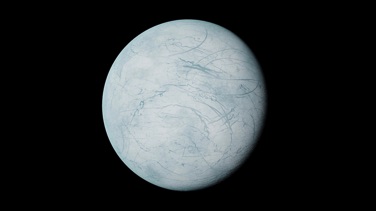TRAPPIST-1h is the farthest planet from the star. It orbits in a near-circular orbit at a distance of only 9.42 million km (0.063 AU) from the star - too far to be habitable. Due to limited data, much less is known about the planet. We know that it is three quarters the size of Earth, but we haven’t yet determined its mass and density. It receives only 13% of the solar irradiance that Earth does, about as much as the main-belt asteroid Ceres, giving it a mean surface temperature of 168 K (-105°C) – too cold for surface water or Earth-type life.
The star’s size as viewed from the surface of TRAPPIST-1h would be one degree across, about twice as large as we see our own Sun. The planet is probably tidally locked to its star, keeping the same face towards it at all times. For a visitor to the sunward side of the planet, the dull red sun would hang in place, neither rising nor setting. The six inner planets would regularly cross the sky, probably transiting (but not eclipsing) the sun’s disk each time, and frequently occulting one another. Unlike our Solar System, the other TRAPPIST-1 planets are close enough to show as small disks, even with naked eyes. At solar conjunction, the closest one, TRAPPIST-1g would appear about two-thirds of the size that our moon does from Earth. On the opposite side of the planet, it would be perpetually dark. The distant stars would rise in the east and cross the sky to set in the west, much more slowly than they do on Earth. With a year only 20 Earth-days long, the entire celestial sphere would be observable every three Earth-weeks!
